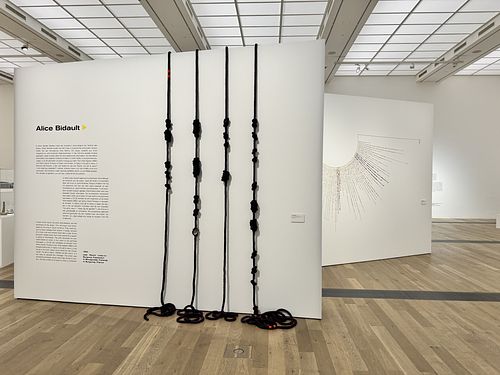AUDIO
Alice Bidault
In the two works featured in this exhibition, French artist Alice Bidault develops her own, unique language. She draws inspiration from a knotted recording system knowns as quipu, which was created by the Inca in South America as early as the seventh century. A quipu is made up of strings and threads knotted in various ways. Both the form and colour of the strings as well as the type of knot used communicates specific information, for instance details about the quantity of goods.
Bidault refers to this technique in her work. In Ogive (“Où gît le voeux.“), she knots colourful pieces of cotton and shells into four long hemp ropes that reach down to the floor. The title of the piece is ambiguous, playing with two different French terms that sound similar. In architecture, “Ogive“ refers to a pointed arch, whereas “Où gît le voeux.” (translated as “where the vow lies”) alludes to a promise, perhaps even a religious vow. Bidault, however, doesn’t provide further explanations. Instead, she encourages us to reflect on how quickly meanings can shift in spoken language, depending on intonation, pronunciation and context.
With in Les pommes sauvages, Bidault refers to a prose text written by American author Henry David Thoreau in 1862. In Wild Apples, Thoreau reflects on the apples that grow in his area, discussing their scent, taste, beauty and mythological significance. His reflections then lead him to contemplate the inherent value of nature and the limitations of human actions. Bidault translates Thoreau’s thoughts into her knotted language. Her work also revolves around individual sensory perceptions and how they differ from official narratives. The artist doesn’t offer any clear or definitive conclusions, as her knotted language cannot be decoded; it remains mysterious and meditative. Her works invite us to create our own stories.
